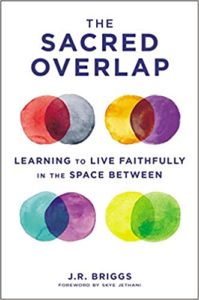Every once in awhile a book arrives on my doorstep at just the right time.
 Our current cultural, economic, and political realities leave even the most critical observer in need of a reminder of what it means to be the presence of Christ in the world. No author can meet every reader’s expectation, and Briggs’s style is sure to let down those looking for a justification of one extreme or the other. But for those who have the eyes to see and ears to hear, he offers us the possibility of a way between the polarities that so often leave us frustrated and longing for an alternative. Briggs argues, of course, that the paradoxical way of Jesus is the alternative in need of recovery by the whole Church. Predictably, Briggs leans into the work of influences like Eugene Peterson, Dallas Willard and N.T. Wright. But it’s his attempt at bringing the whole scope of Christianity to the forefront–both ancient and modern–that gives the book its animating edge.
Our current cultural, economic, and political realities leave even the most critical observer in need of a reminder of what it means to be the presence of Christ in the world. No author can meet every reader’s expectation, and Briggs’s style is sure to let down those looking for a justification of one extreme or the other. But for those who have the eyes to see and ears to hear, he offers us the possibility of a way between the polarities that so often leave us frustrated and longing for an alternative. Briggs argues, of course, that the paradoxical way of Jesus is the alternative in need of recovery by the whole Church. Predictably, Briggs leans into the work of influences like Eugene Peterson, Dallas Willard and N.T. Wright. But it’s his attempt at bringing the whole scope of Christianity to the forefront–both ancient and modern–that gives the book its animating edge.
The paradoxical way of Jesus is the alternative in need of recovery by the whole Church.
Tweet this.
If it wasn’t so hard to pronounce or spell– the book might well have been titled The Mandorla Manifesto. It’s his notion of the Mandorla– the Italian word for almond–that grabs the reader’s attention threading the needle from beginning to end. With the aid of helpful illustrations throughout, Briggs points again and again to the Mandorla as the mandate for those who follow the way of Christ. The mandorla is that middle space in the Venn diagram. It’s a hallmark of Christian art. As I write this review, I do so while glancing at an icon of Christ enthroned in the midst of a mandorla. As a child, I was taught that the Christian icthus or fish symbol was preferable to other Christian symbols. What I wasn’t taught–at least explicitly– was that the making of the icthus by those early Christians were two literal lines in the sand placing the follower of the Jesus way in an altogether different kind of space. The mandorla becomes a demarcation zone where we place our allegiance to another King and Kingdom. This is difficult but necessary alternative reality for a 21st century American Christian to grasp not because it demotes democracy or supposes an earthly theocracy but because it calls us higher toward a more excellent way that, one day, causes every knee to bow.
With his clever use of mixed-up-mashed-together words, descriptive sentences, and stories from his life including climbing a barbed-wire fence into an actual demarcation zone; Briggs chips away at our tendency for an either/or existence showing the preferable and peculiar paradox of the one who was both fully human and fully divine and how that singular example leads us toward faithful living in the midst of the tension of our age. He summarizes the important work of Stanley Hauweras and Will Willamon who suggested some 30 years ago that Christians are called to live as resident aliens in the surrounding culture. His pages helpfully introduce readers to various Christian practices for worship and evangelism that are normative for some but will be unfamiliar or even forgotten by others. He challenges our gnostic tendencies–body/bad-spirit/good– that have so neutered the Church’s witness and makes plain that, for the Christian, eternity doesn’t begin when we die. It is now. That his argument cuts through old divisions around evangelism and discipleship making room for the streams of the church who embrace becoming Christian as a process and those who stress an exact moment of conversion will make for a few unhappy readers. But such is life in the mandorla.
While his penchant for reflective listening, good questions, and fresh expressions of church provides a framework for how his readers might practice the sacred overlap, Briggs is quick to emphasize that ministry–like politics–is local. What may work his primary context for ministry (greater Philadelphia) is likely different from what may work in Pensacola or Phoenix. But this speaks to his humility as an author and his deeply rooted experience as a pastor and an active participant in the work of the local church. The good news is that Briggs isn’t asking anyone to attempt anything that he hasn’t attempted already. And for this, his words demand our careful consideration.
Briggs concludes his argument with a clarion call to civility– a way of living with gentleness and respect–that is less an anemic notion of tolerance and more about a radical and active way of loving that convenes uncomfortable conversations drawing stakeholders from every side thereby creating a new imagination for the life of the world and the life of the world to come.
If you’re a frustrated Christian looking for a much-needed nudge to talk about the issues you’ve wished to talk about but didn’t think you could, The Sacred Overlap will prove to be a refreshingly hopeful companion.
Tweet this.
For the last several years, I’ve had the privilege of working alongside Briggs on the US Fresh Expressions Team and he says many of the things that we have said for years. But while the rest of us can’t resist moving on to the next thing. Briggs makes the time and space to write it all down. If you’re a frustrated Christian looking for a much-needed nudge to talk about the issues you’ve wished to talk about but didn’t think you could, The Sacred Overlap will prove to be a refreshingly hopeful companion.
Check out The Sacred Overlap here– and grab it at a special FX-discounted price!
The cultural, religious, political, relational, and familial divides are growing stronger; the arguments are becoming more explosive; and the defending of our opinions is growing more and more intense. Even a global pandemic, which had the potential to unite us and draw us together, has driven us further apart. If there is ever a time for the church to see a crucial opportunity to bring hope to our current context, this is it. The widening of extremes provides the church a fertile opportunity to live in the midst of the tension, to live in radical love and faithfulness between the extremes.


